
Kinetic Lights and Clearwing Combine Gear for a Reflective Show
Michael Brown has been looking after lighting Bon Iver, a Wisconsin based Indie band, since 2012. The band has grown in stature and can fill arenas in America, but it often opts to play more intimate shows in theaters. The most interesting portion of this particular design was the use of a Kinetic Lights motion system, which featured LED, lined mirrors that were suspended in many different shapes. Twenty-five mirrors flew into assorted formations via three winches per unit. Not only were they architecturally pleasing to the eye, they provided a surface for Brown to bounce light beams off of.
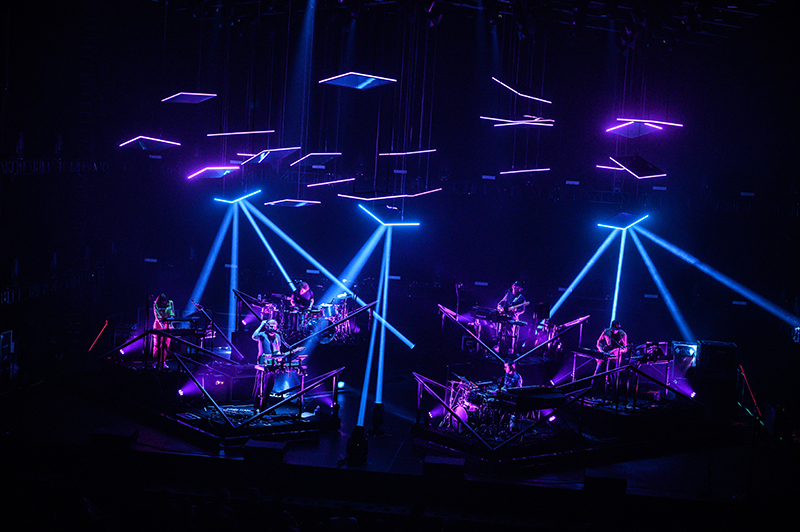
Brown admits he’s a theater kid at heart and it informs his work to this day. He started volunteering at his local community theater at the age of 14. He explains, “Looking for more challenges and opportunities to make an impact in the shows we were producing at the theater, I started designing the lights with a friend of mine. That practice remained a constant throughout high-school and into college at Middle Tennessee State University, where I got a Bachelors in Theatrical Design. During my time in college, I would do summer stock theater at Williamstown (MA) Theatre Festival in the Berkshire Mountains.”
After graduating in 2004, a group of fellow Williamstown designers and Brown decided to move to New York to pursue theater. That decision and the people that he met along the way led to a design career in theater, fashion, and lighting corporate events and installations around New York. “That’s how I met most of the artists I work with now. Brooklyn in the mid-2000s was a magical time of creation.”
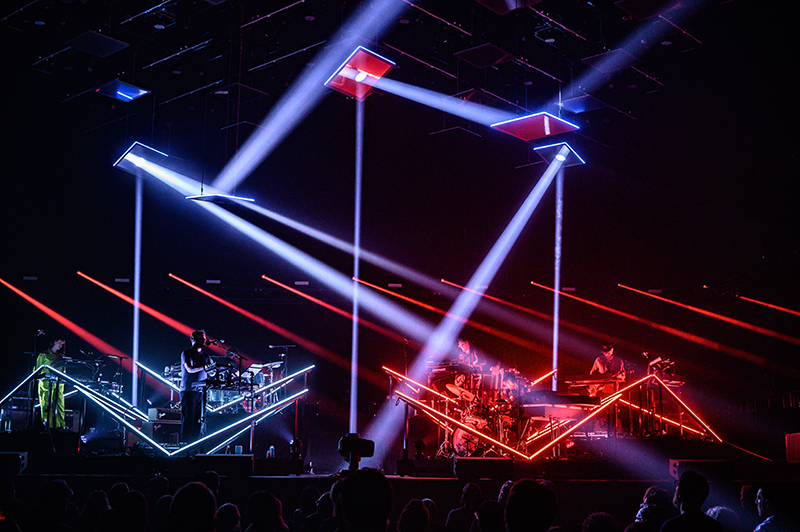
We asked Brown how he met Justin Vernon (the leader behind Bon Iver). “I met Justin in 2009, backstage at a Grizzly Bear Concert in London. It was the first European show I had ever done, and I wasn’t even supposed to be there. Unbeknownst to me, Grizzly Bear and Bon Iver had become friends on the 2009 summer European festival circuit, playing the daytime slot (read: no LD needed). But there was one indoor show on the schedule that I knew would be an important show for the band. I took it upon myself to buy my own plane ticket to London and rent a couple of lights to surprise the band. After that show, a guy walked up to me and said, ‘Hey man, really great show. My name is Justin. One of these days maybe we can work together.’ But it wasn’t until the end of 2012 that we finally linked up. We have collaborated on many things since then!”
Justin Vernon and Bon Iver were widely respected as a regional artist and act before hitting the big time. “We’ve been lucky to have really good organic growth, from theaters to sheds to arenas,” Brown says. “This tour is the largest we’ve ever put together. And while it’s the first full arena tour we’ve ever done, we’ve done arenas in select markets and bigger one-off shows over the past two years. Those shows gave us enough of an intrigue and experience to really dive-in on this production and show our audience that you can bring an intimate and engaging show to the arena environment if you do it right.”

A Reflective Show
With this design, Brown dove headfirst into the world of kinetic light and moving mirrors. We asked him how he came across this system. “I discovered WHITEvoid and Kinetic Lights while researching art projects for our Wisconsin music festival, Eaux Claires. I love their work and wanted to figure out a way to incorporate them into the festival, but the outdoor environment in Wisconsin didn’t allow a good opportunity. I actually contacted Christopher Bauder (See sidebar, page 45) and WHITEvoid in 2016 with a radically different idea, but that project wasn’t tourable and we hadn’t quite figured out how to pull any of this off. In late 2018 when Justin said he wanted to go for it and try arenas, he gave me the blessing to take full creative control of the production. I knew exactly what I wanted to do and started the conversation again with WHITEvoid.
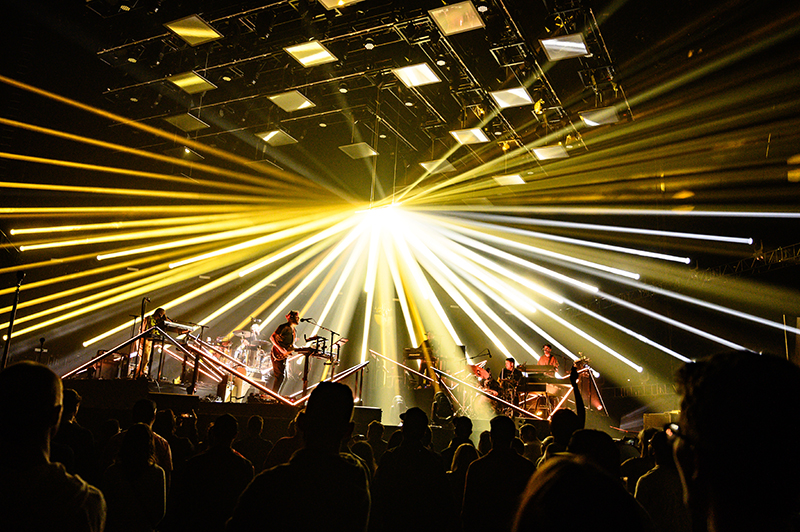
“After the initial failure to work together in 2016, I didn’t want Christopher and his team to think we were wasting their time, so when I reached back out in 2018 I had the full concept and the core of the production design already completed,” Brown adds. “I knew the geometry, design, and the layout of the elements, but I needed Christopher and WHITEvoid’s expertise to begin the process of creating the 3D geometry and conceptualizing the movements of the kinetic elements. It’s quite overwhelming to approach 3D space and the patterns you can create, because of its endless possibilities. This show is a great collaboration in that the process was a true back and forth of ideas that have become the final production.
“Christopher put me in contact with Peter Thompson from the Las Vegas office (Sidebar, page 49) to figure out the logistics and see if the project was even logistically possible,” Brown adds. “WHITEvoid and Kinetic Lights are sibling companies, but they execute different aspects of a project. WHITEvoid is the creative arm. Kinetic Lights is the winch technology.”
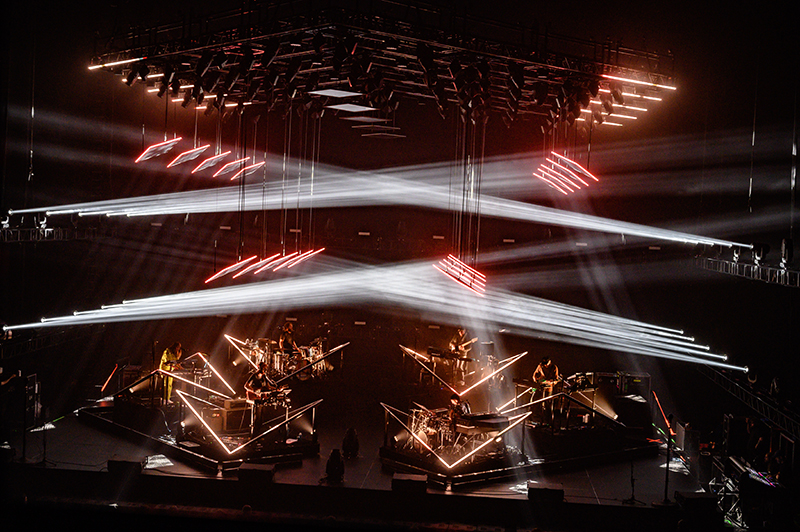
Chevrons and Diamonds
The rig consisted of five identical sized overhead truss sections that were made by 32-foot sections of GT truss connected by a 90° corner block to form a chevron. These five chevrons resembled a diamond shape to the audience, matching the riser layout of the musicians.
Suspended from each truss were five individually flown square mirrors, turned 45° so they took on a diamond shape as they came in and out. These were all symmetrically hung so in reality there were five vertical rows of five mirrors, 25 in total. Three Kinetic Lights winches (which can hold up to 5 kilograms) could move these mirrors to create any number of patterns based on the balance required to create as many patterns and positions as possible. The Chevron trusses were all suspended from a mother grid of truss above that. This was done to insure the five trusses and the mirrors were precision hung in the same spot every day.
“The layout of the risers and the mirrors is lined up intentionally to allow the overhead lights functionality. Everything in this lighting rig is literally placed within a half inch of tolerance. Sam McKeown from Clearwing (crew chief and systems design) probably hated me during prep as the layout had to be exact within a ridiculous amount of precision.” Martin MAC AirFX and GLP X4 impression fixtures were strategically placed in the same GT trusses to light the band from above while missing the mirrors.
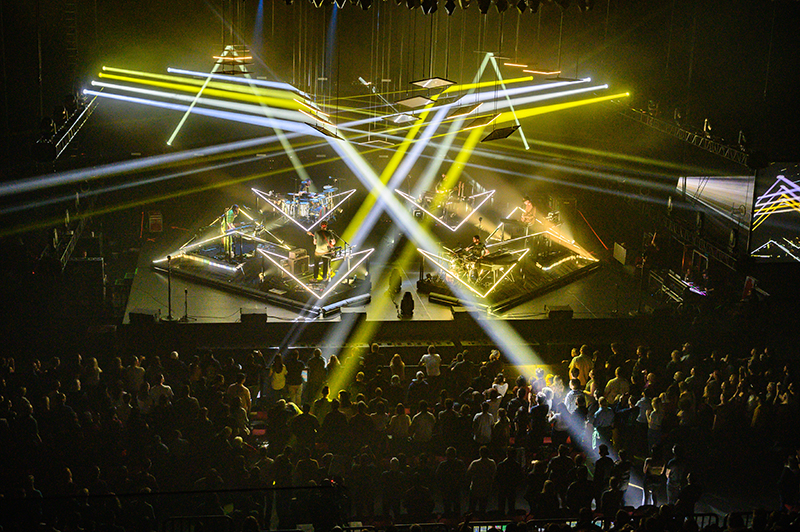
The riser configuration is basically six risers, set 45° perpendicular to the stage edge, each containing one musician and their gear. Brown expands, “The entire production design originates from the configuration of the band’s risers, and specifically the design choice to orient our 8’ x 8’ risers as diamonds. Not only are the risers spun 45 degrees to become diamonds, but the riser placement on the stage is also in a diamond configuration so that no one is on-center. This allows the band to play to each other as if they were in a circle. From there, the diamond Sceptrons (single lines of LED assembled in a straight line) extend above to the diamond mirrors overhead with spacing that matches the band members spacing on the stage (8’ centers.) It made sense to make the trusses chevrons because of the perspective you see with the diamond mirrors. In most of the geometric configurations, a viewer can only see two of the four LED sides of the diamond mirror and that creates the illusion of a chevron. It just made sense to play with that geometry and reflect that illusion in the truss configuration.”
Surrounding each riser are some diagonal like railings that seem to frame each riser in a diamond shape. It gives the image that each riser is surrounded by a peak and valley made up of Pickup sticks. Except the sticks glowed. Brown explains how they came about. “I like to draft in Vectorworks and do 3D work in LightConverse. I mocked up the Sceptron design in LightConverse and sent over the idea to Sam, my crew chief from Clearwing to finalize and figure out the exact angles and fabrication logistics. Clearwing Milwaukee fabricated the custom brackets with a really fantastic local metal-worker they use.” Clearwing provided all of the touring structure, lights, rigging and set risers out of their Milwaukee location.
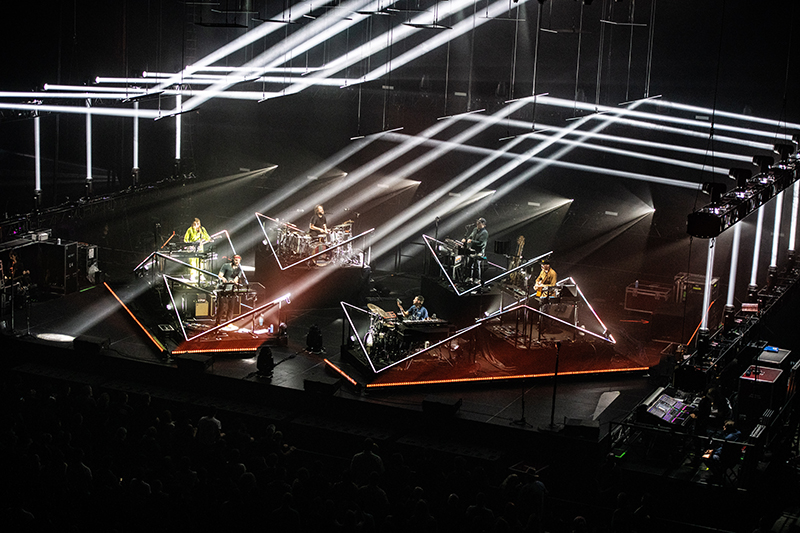
All of the video content in the show is pixel-mapped onto Sceptrons, X4 Bar20s (which surround the riser layout), and X4 units. Brown expands “I have been wanting to try some different tools for pixel-mapping and this project was a good one to test out something new. The more companies can make flexible tools to integrate video into lighting, the more they will see users gravitate to their products. Avolites Ai is working to make a flexible interface. It’s a good all-in-one option for pixel-mapping and video playback.”
On each side of the stage are 48-foot sections of GT truss with another equal truss sub-hung 10 feet under that one. Across the rear of the stage is a 72-foot-long truss about ten feet off the deck. The basic concept of these trusses is to hold Robe MegaPointes that will be used to bounce lights off of the mirrors as well as form great architectural patterns. When asked why he chose these fixtures Brown states, “WHITEvoid and Kinetic Lights have done lots of testing and the MegaPointe is the most precise fixture they found in their research. I already love MegaPointes for their brightness, beam quality, and CMY mixing. It was such a relief when Peter told me that they were the best light for the pan/tilt precision needed for our project.”
There is no front truss, though the LD is able to top light the band at times now. “We have done tours in the past where Justin asked me to never light his face. I understand that motivation and it actually works. I love to create
environments first and foremost, it’s all about escapism for me. But I knew that these larger environments would exaggerate that effect and I knew I wanted to see more information in these rooms, to help people feel connected to their performance. We are a very democratized band and while each band member gets their moment in the show, it’s not about spots. But it’s nice to have moments where we aren’t shrouding the band in shadows. It’s time to let the audience in a bit more and see more of that information.”
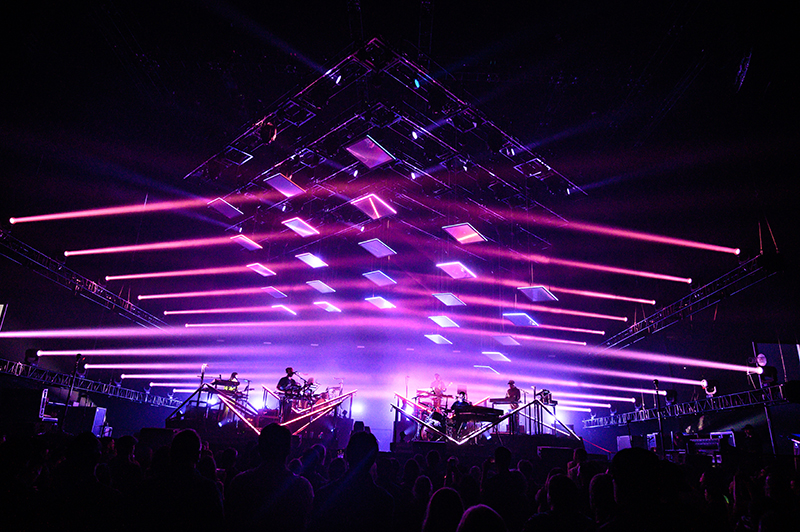
The Vendors On Tour
PLSN asked the LD about his relationship with Clearwing Productions. “Our relationship with Clearwing began with our Wisconsin festival, Eaux Claires. Our Account Rep, Steve Harvey, bent over backwards to make our creative project a success. Since then, Clearwing and Steve have been with us every step of the way and are willing to go to extents that other vendors wouldn’t. It’s not just about the lights. It’s about the infrastructure, the people, and the build. They understand that we demand extreme detail and they won’t put something on tour with us without that level of attention. We understand each other and it’s worth it for us to keep a partner that not only wants to get it right but keeps it right.”
Everyone on the tour seems to have a great deal of respect for the crew boss. Brown expands, “Sam McKeown is our crew chief and helped me design all the systems and integration for the show. He has really made himself indispensable since we started working together in 2016 and still comes with us wherever we go, regardless of the continent. He’s the glue that makes the integration of this design possible. Sam also worked closely with Peter to make our systems more efficient and ultimately, tourable in a demanding timeframe. Sam employs a level of detail and efficiency that few people are willing to entertain. It shows in the speed and precision of this rig.”
As far as mirror technology we asked Michael if he feels he’s exhausted this Kinetic Lights moving mirror technology. “Oh we’re just touching the tip of the iceberg. We only have mirrors overhead!!! I imagine at some point we’ll do another configuration of this production (perhaps in the round)? There’s also way more potential to extend these elements out into the audience ever further.”

The Show Looks
From our view, it appeared that Brown utilized light more as a scenic element itself and to punctuate the music, than actually illuminate the band. It provided illusions of bending light or having a hundred beams emulate from one source (mirror). We asked if he found his work to be more interesting…, against the grain of the normal concert visuals? “I love the workflow of this show and how it can create a story that ties the entire performance together. I approached this design from more of an architectural background, utilizing the mirrors and the geometry of the lighting to create an evolving scenic element to the show. The ability to create ever-changing animations and morphing geometry allows a versatile approach to the production that keeps revealing new tricks as the show develops. It also helps that this band is so focused on playing pristine music within these intricate worlds (their risers) as opposed to running around the stage or working the room. That means that I don’t have to use spots or any methods to light the band that would break the geometry of the rest of the rig. We’re working together to present a cohesive show and lighting the band is built into the overall design so that all of those beams work together to the overall stage picture.”
There were times where the only light emitted on stage was an upwards rain curtain from GLP X4 Bar 20 battens surrounding the risers. At other times several floor lights may hit a selected mirror for a few scant beams. On some occasions the light beams appeared to bend. In the end Brown states, “I find myself wanting to explore the art-world and focus on collaborations such as this show. The more I work with other artists, the more I want to refine my own aesthetic as uniquely my own that works together as a collaboration and is presented as a sum that’s greater than its parts. That approach is currently what I find the most rewarding creatively-speaking.”
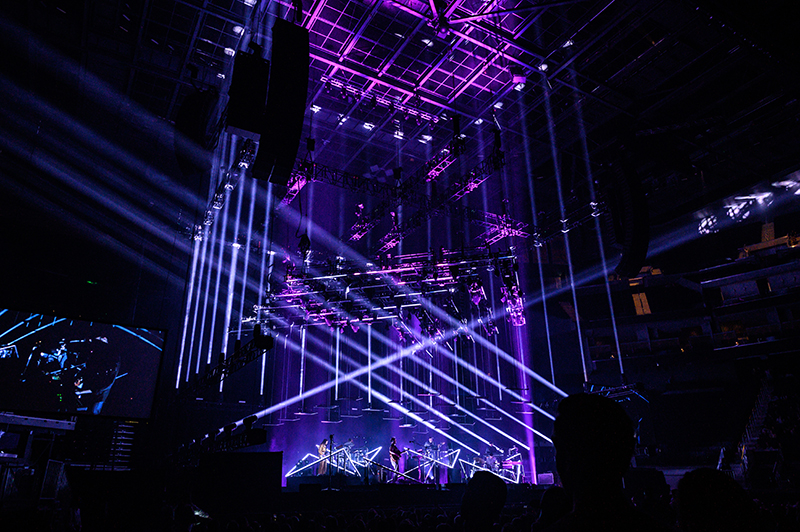
A Q&A with Christopher Bauder
PLSN caught up with Christopher Bauder, who started developing Kinetic Lights 15 years ago, before officially launching the company in 2009.
PLSN: How did Kinetic Lights begin?
Christopher Bauder: I had already used very early versions of our winch system for art shows in 2005. The first commercial event application was realized for a trade fair stand in Switzerland in 2009.”
Does your company make all the various devices we see them fly on your website, kinetic-lights.com?
Everything you see on the Kinetic Light website is designed and manufactured by Kinetic Lights in Berlin. This includes the motor systems, the lights and mirrors as well as all the control software and interfaces.
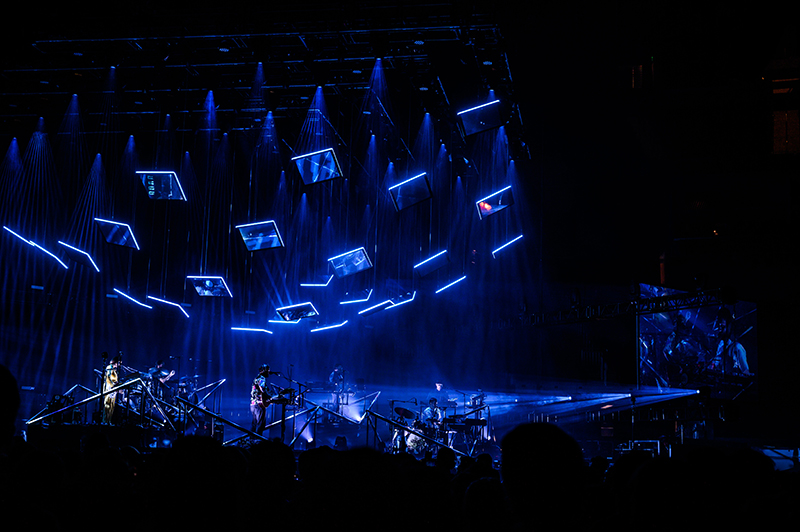
Can you explain the connection between WHITEvoid and Kinetic Lights? Do you actually sell these winch systems, or do you just have vendors in the USA, Japan etc. that lease the Kinetic Lights equipment for various events?
The systems for the Bon Iver tour were directly rented from Kinetic Lights Germany. WHITEvoid is the mother company of the Kinetic Lights brand also based in Berlin, Germany. WHITEvoid is a design agency specialized in show design, lighting design, scenography and interior architecture. Kinetic Lights was split off as an independent brand about 10 years ago. This allows other design agencies and technical companies more direct access to the products.
Kinetic Lights sells and rents the motor winch systems worldwide. We often do permanent installations or complex and large scale rentals directly. But we also have partners worldwide that own systems that can be rented by third parties. We also have very strong partners in the U.S. based out of Vegas who handle most of our sales and rental business in the states.”
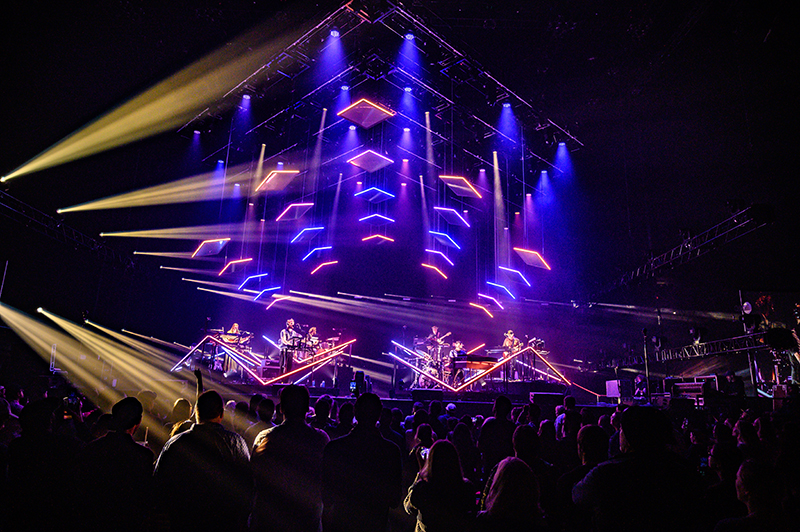
How do you collaborate with Michael Brown and how the system works, as far as pre-programming movement cues?
Michael Brown approached us with an idea for a kinetic mirror and lights show loosely based on one of our previous kinetic designs. He also provided us with a breakdown of the songs Bon Iver would perform during the tour with his lighting design ideas for each song. These included the general look and feel, color combinations and rough ideas for light animations and fixtures to use.
In turn, we created some simple 3D sketches illustrating possible combinations of moving lights and kinetic mirror positions and animations that could match his song ideas. Then we sat together refining and detailing each song that included a kinetic lighting part. Then we programmed the movement patterns of the mirrors and tracking positions for the MegaPointes in the KLC control software, which is based on the TouchDesigner platform.
Michael preprogrammed the whole light show with the grandMA2 apart from mirror movements and tracking of moving lights. During the show he triggers the motion cues in the KLC software via his grandMA. Each motion cue in KLC provides the pan and tilt information for each moving light to target the respective mirror and follow it while moving. All other functions of the light like color, dimming and gobos are controlled directly from the grandMA via DMX merge. The LED rim lights along the frame of each kinetic mirror are controlled via DMX as well.
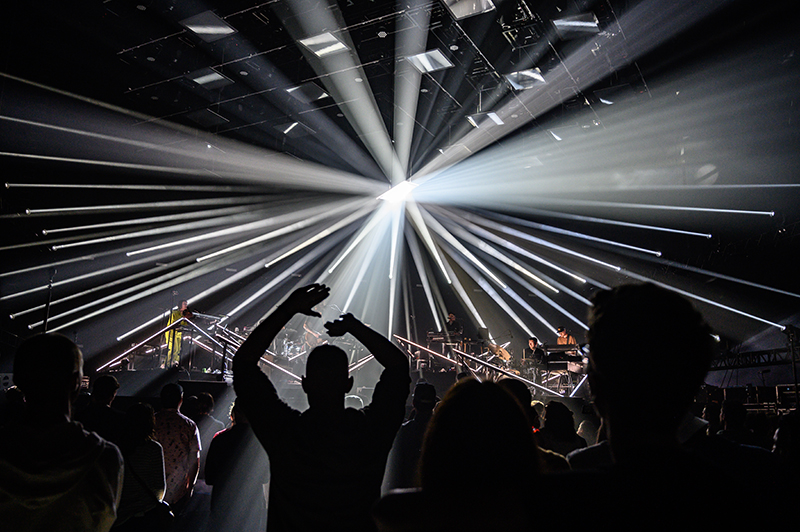
A Discussion with Peter Thompson from WHITEvoid
While on site, we took the time to quiz Peter Thompson from WHITEvoid on his company’s affiliation with the Kinetic Lights system and how this gear works. Peter is a native Texan who toured for years before setting up residence in Las Vegas. We asked about WHITEvoid, and how Peter came across Kinetic Lights.
They are specialists in space, light and media design, Thompson says. “WHITEvoid is a company in itself. Kinetic Lights is a brand we represent. Lis Roncato, our executive producer manages the business and design collaboration. As a new technology, she manages the level to which we collaborate artistically with our client collaborators. WHITEvoid provides as little or as much design input as the client desires, it’s a sliding scale of collaboration.”
Thompson handles the technical side of things, project managing with software, logistics, and technical integration teams in Berlin to ensure they meet the client’s needs and integrate into third party rigging, lighting, and video systems. “Both of us comprise the sales/integration team worldwide and handle rentals in the Americas. We approach sales as if it is a series of creative, budgetary and technical problems to solve. We then scale, design, and tech a system to suit their needs or we tell them in as kind a way as possible that our system is just not feasible for their application.
“My partner and I befriended Chris after visiting their facilities in Berlin in 2014, and later at the Lyon Lighting Festival in 2016, where I came across his products while researching new technologies for Cirque du Soleil,” Thompson adds.
As for the company that built these custom designed mirrors, “they are Kinetic Lights by WHITEvoid,” Thompson explains, “custom lighting elements made in Berlin, Germany. They are a fully diffused lighting element (not just LED tape).” He adds that they are “designed by our engineering team led by Johannes Langbein and supported by Wagner Mardegan, who worked directly with Christopher Bauder (CEO, Creative Director) on the product design.” To get the winches to hang in the precise placement under the GT truss, custom brackets were developed. Peter explains, “These brackets were designed by Box of Wishes Inc., my consulting and design firm. Then manufactured by Magnus Metals under the guidance of Angelo Pappano in Las Vegas.”
The system that Kinetic lights uses interacts with the grandMA console to ensure that the beams stay concentrated on the mirrors, even when they are in motion. We wondered,
‘In simple layman’s terms, how does Kinetic Lights accomplish this? How many focus positions does it need Michael to update each day?’” Thompson replies, “Ours is a full tracking system, so once Michael merges our Art-Net signal through the grandMA to the Robe MegaPointes we control them and our software handles the Pan, Tilt, and Focus to ensure they remain in ‘3D Sync’ with the mirrors. We tweak the targeting of the system every-time we load-in to compensate for small tolerances and shifts in the rigging and in motors of the moving lights themselves, and then our software does the rest!” They simply check and update a high and a low focus position for each MegaPointe per mirror based on what is used in the show. The system does the rest.
We asked Thompson how Kinetic Lights gets signal to their winches and LEDs. “Power and signal are delivered to the winches just like a moving light,” he notes. “We use a proprietary protocol (not just DMX) that will work across a 5-pin cable and data distribution system and that will also send safety feedback to our control system in keeping with EU safety standards. The Winch then provides power and control to the lighting elements through a second proprietary system.”
As far as cables getting tangles with the moving mirrors, they’ve solved that, too. “We have a patented flat cable that incorporates power, data, and lifting cables in the same cable. One cable to rule them all. We have perfected it over the years to prevent tangles and bunching so that the connection between the winch and lighting elements disappear under the right lighting conditions.
“Christopher introduced Michael to the Las Vegas office of Kinetic Lights/WHITEvoid to start the conversation with Michael, we (KL/WV Americas) did the feasibility study and then did the project management to create a rock ‘n’ roll tour-able version of this system that previously took 6-10 days to set-up, program and debug.”
Bon Iver 2019 Tour
Crew
Touring Crew:
- Production and Lighting Designer: Michael Brown
- Clearwing Crew: Sam McKeown (Crew Chief), Bradley Rooks, Bartholomew Freed, Kelsey Gonzalez
- Production Manager: James Dean
- Stage Manager: Phil Riehl
- Riggers: Neil Werries, Jeremy Bryden, Mike “Cosmo” Flannery
- Carpenter: Jose “Pancho” Ramirez
Kinetic Lights/WHITEvoid GmbH
- Art Direction Kinetics: Christopher Bauder
- Project Director: Peter Thompson
- Executive Producer: Lis Roncato
- Mechanical Engineering: Johannes Langbein, Wagner Mardegan
- Technical Managers: Florian Fink, Marc Liebold
- Previz Kinetics: Lukasz Mroczkowski
- Software Development: Corey Schneider, Manu Bossard
- Kinetic Lights Technicians: Kenneth Danielsen, Franscesco Previtali
Gear
From Clearwing Productions:
- 2 grandMA2 Light consoles
- 1 grandMA2 on PC
- 4 grandMA NPUs
- 12 GLP Impression X4s
- 28 GLP Impression X4
- 36 GLP Impression X4 Bar 20
- 32 Martin MAC Viper Performance
- 49 Robe MegaPointes
- 16 SL Nitro 510C
- 58 VDO Sceptron 10 – 322mm (sq diffuser)
- 58 VDO Sceptron 10 1m(sq diffuser)
- 5 P3 PowerPort 1500
- 4 MDG Me2 hazers
- 4 Martin AF 2 Fan
- 6 5’ sections Tyler GT truss
- 76 8’ sections Tyler GT truss
- 5 Tyler Truss 90° corner
- 22 Tyler GT truss lifting plate
From Kinetic Lights:
- 75 Kinetic Lights winches
- 75 Kinetic Lights square mirrors
- 2 Kinetic Lights KLC3 control systems


